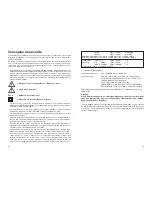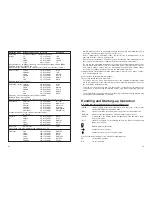
22
Safety Instructions
Damage due to non-compliance with these operating instructions leads to the expiry
of warranty! We accept no liability for consequent damage.
We accept no liability for damage to property or injury to persons caused by the mis-
handling of the device or non-compliance with the safety instructions. In such cases
the guarantee will lapse.
- These devices have been designed in compliance with VDE 0411 part 1 = EN or IEC
61010-1DIN 57 411 / VDE 0411, safety requirements for electronic measuring
instruments, and left the factory in perfect condition in terms of safety engineering.
To maintain this status and ensure safe operation, the user must comply with the
safety instructions and warnings contained in these operating instructions.
= Caution! Dangerous voltage, do not touch! Danger!
= Read the operating instructions!
CAT II
= Overvoltage category II
= Insulation class 2 (double insulated)
- Measurements of currents are only permitted in such electric circuits which them-
selves are secured by 20A and in which the voltages do not exceed 250VAC or
VCD (250V fuse).
- The measuring instruments and circuits are not protected against electric arc
explosions (IEC 1010-2-031, section 13.101).
- Measuring instruments and accessories should be kept out of the reach of chil-
dren!
- In commercial institutions, the accident prevention regulations of the Employer’s
Liability Insurance Association for Electrical Systems and Operating Materials are
to be observed.
- In schools, training centres, computer and self-help workshops, handling of measur-
ing instruments must be supervised by trained personnel in a responsible manner.
- Take particular care when dealing with voltages exceeding 25V alternating current
(AC) or 35V direct current (DC). Even at these voltages it is possible to get a fatal
electric shock if you touch electric conductors. Therefore, first de-energise the
voltage source, connect the measuring instrument to the connections at the volt-
age source to be measured, set the required voltage measurement range at the
measuring instrument, and then switch on the voltage source. When the measure-
ment has been completed, de-energise the voltage source and remove the cables
from the connections at the voltage source.
35
5MHz
±(0.1%+3dgts)
0.001MHz
10MHz
±(0.1%+3dgts)
0.01MHz
Sensitivity higher or equal to ca. 300mVeff from 1Hz to 1MHz
Sensitivity higher or equal to ca. 600mVeff from 1MHz to 10MHz
Temperature
-40°C... 0°C
±(3.0%+4dgts)
1°C
measurement
0°C… +400°C
±(1.0%+3dgts)
1°C
+400°C…+1000°C
±(2.0%+10dgts)
1°C
Temperature measurement possible with VC-840
C Maximum input values
Voltage measurement:
max. 1000VDC or 750VACrms
Current measurement:
10A AC / DC in the A-range, for max. 10s with a subse-
quent cool-down phase of min. 15min., max.
250VDC/VACrms, overload protection:
quick-acting 20A-250V ceramic fuse
400mA AC/DC in the mA-range, max. 250VDC/VACrms,
overload protection: quick-acting 0.5A-250V ceramic fuse
Resistance measurement, diode test, continuity check, frequency measurement:
max. 1000Vpeak
Caution!
If the maximum permissible input values are exceeded, the measuring instru-
ment will be damaged and under unfavourable conditions the user’s life will be
endangered seriously.
In an environment with high electrostatic discharges (± 4kV), malfunctions can be
caused when the measuring instrument is used. In case of malfunctions (irrational
characters in the display etc.) switch off the device and then switch it on again
(reset). Avoid the use of the instrument under such conditions.







































